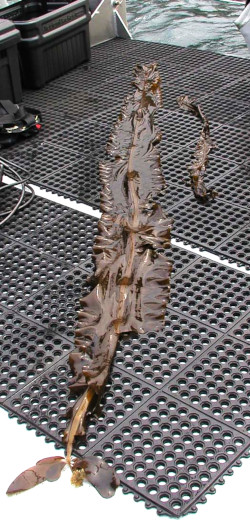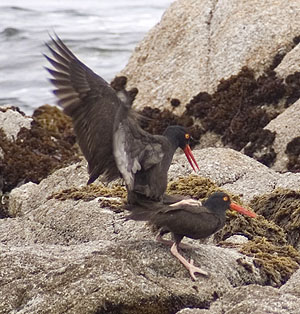
|
|||||||||||||||
|
| |||||||||||||||
|
Tide-pool organisms Annual brown algae recolonize rocks Coralline red algae Perennial red algae Surf grass Lined shore crabs Barnacles Predatory snails Overwintering shorebirds leave Black oystercatchers |
The intertidal space race: Central Coast tide pools (and kelp beds) are often pretty mangy looking in March, after having been scoured by winter storm waves for months on end. In addition to the forces of the waves themselves, intertidal rocks on the Central Coast are often exposed to immense, floating redwood logs that act as rock scrapers or battering rams, tearing algae and animals from any exposed surface. 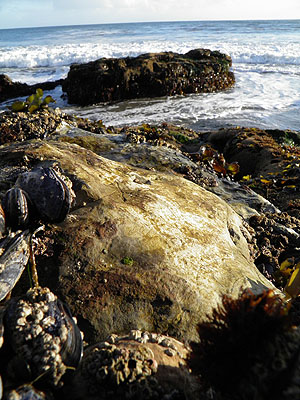 The barren spot on this rock probably was covered by mussels at some point. After the mussels were scraped off by winter storm waves, the space was colonized by an owl limpet, whose lumpy shell you can see in the foreground. The owl limpet continually grazes this cleared territory, removing both algae and young mussels or other would-be settlers. (Source: Kim Fulton-Bennett) The flip side of all this death and destruction is that it creates areas of bare rock that provide many opportunities for new life once the storm season is over. In fact, the more severe the winter, the more space will be available for colonization. The first colonizers are bacteria, diatoms, and blue-green algae that, within a matter of weeks, form thin films on any bare rock surfaces exposed by winter waves. Such films are often invisible to the naked eye but they make bare rock surfaces extremely slippery and treacherous for humans navigating intertidal rocks. Diatom films also provide a bounty for grazing animals such as limpets, snails, and some crabs, which have devised various ways of scraping these diatoms and algae off the rocks. In fact, some limpets (such as the owl limpet shown above) actively seek out bare rock areas, and by constant grazing, keep these areas clear of other algae and animals. Rocky intertidal areas, like kelp beds, are continual battlefields where animals and algae compete for any available surface on which to settle down, grow, and reproduce. In this never-ending struggle, spring is a particularly competitive time of year, especially for the algae. The algae and animals competing for space in spring must also deal with the return of sand to the beaches. As in the kelp beds, “waves” of sand migrate back and forth, alternately burying and then exposing areas of bare rock. Some organisms, such as sea anemones, can survive being buried for months; others, such as limpets, move away if they can. Some permanently attached organisms such as barnacles cannot survive more than a week or two of burial before succumbing. But that doesn't stop the next wave of settlers from trying again, as new potential colonists arrive with each high tide. March is a good time of year to poke around the tide pools and observe some of the different strategies that intertidal algae and animals use to survive or recolonize following winter storms. Perennial brown algae regrow Many perennial brown algae live in the tumultuous zone between the inner-most kelp beds and the deeper tide pools. Known to marine biologists as the "subtidal zone" and to surfers as the "impact zone," this challenging environment is exposed to nearly constant wave activity and is frequently scoured by drifting sand. Such subtidal areas, where the water is usually six feet deep or less, can be explored by anyone willing to brave slippery rocks at the very lowest of the low tides. In areas with giant kelp beds offshore, you are likely to see at least the the holdfasts at least three different types of perennial algae in the intertidal zone: feather boa kelp (Egregia menziesii), bladder-chain kelp ( Stephanocystis osmundaceae, and a nearshore variety of giant kelp (Macrocystis perifera). During March, you may see only the holdfasts and eroded remnants of these kelps. They have survived the winter by shedding some or all of their blades and stipes. By March, however, if you look closely, you may see small stipes and blades beginning starting to grow out from the surviving holdfasts. Feather boa kelp regrows 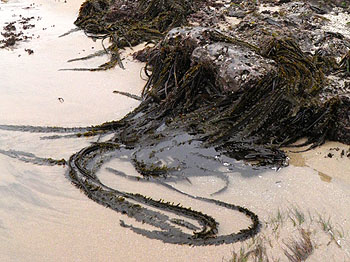 Feather-boa kelp (Egregia menziesii) is a very hardy perennial brown alga that survives in areas of strong wave energy and sand scour. (Source: Kim Fulton-Bennett) Perhaps the most obvious and persistent of these brown algae is feather boa kelp (Egregia menziesii). As its common name implies, this alga looks like a old-fashioned feather boa, with a long, flat, leathery "rachis" fringed with short, feathery blades and floats growing off each side. Many intertidal grazing animals, including sea hares, sea urchins, abalone, and some turban snails, rely on perennial algae such as feather boa kelp as a year-round food source. 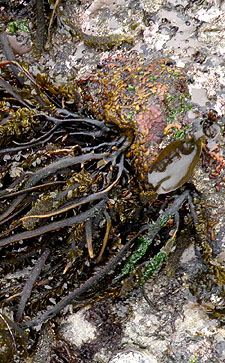 The holdfasts of feather-boa kelp (Egregia menziesii) have pit-like depressions that protect stipes from being scraped off by winter storm debris. (Source: Kim Fulton-Bennett) Strands of feather boa kelp can reach 25 feet long by the end of their summer growing season. In March, however, most strands are tattered and broken, and only a foot or two of the stipe remains. At the same time, new strands begin to sprout from the kelp’s low, conical holdfast. Although typically only an inch or two high, feather-boa holdfasts cling to rocks even more tightly than do the holdfasts of giant kelp. They are shaped like miniature volcanoes, with the stipes growing out of a deep, protected central crater. This arrangement presumably reduces the chances that the stipes will be sheared off by wave-borne logs or other debris. Bladder-chain kelp regrows Bladder-chain kelp (Stephanocystis osmundacea) is easy to recognize because of its thin, bushy, branching stipes, small, light-brown, frilly blades and chains of tiny (1/8 inch-diameter) bead-like floats, which remind me of Sargassum weed. The lower part of the stipe is much thicker and sturdier, more like what you would expect for an alga that lives in the "impact zone." This kelp is often found somewhat deeper than feather boa kelp, along the inner edge of giant-kelp beds. In areas where it competes for light with giant kelp, bladder-chain kelp can grow to over 25 feet long. Although its floats sometimes grow all the way up to the surface (especially by late summer and in protected locations), the blades of bladder-chain kelp usually lie below the surface. This reduces damage from breaking waves and allows bladder-chain kelp to survive as an understory alga beneath giant-kelp forests along the more exposed coast between Santa Cruz and Davenport. Each winter, the upper part of bladder-chain kelp (the part with the floats) is torn off by storm waves, but the lower, sturdier part usually survives. A few larger blades on this lower section often survive winter storms, allowing the alga to collect sunlight until the upper portion grows back in early spring. Laminaria regrows One of the more common intertidal and subtidal kelps is Laminaria setchellii. Each Laminaria holdfast puts out a single short, ropy stipe that with five to seven broad, flat blades fanning out at the end. When full grown, each blade is a few inches wide and from four to eight feet long. Sometimes these blades are torn off during winter storms. More often, they survive at least one winter, and only begin to disintegrate during their second fall, when they release spores and die. You can also find Laminaria on wave-washed intertidal rocks in spring, when only the stipe and one or two tattered blades remain. Rockweed regrows Rockweeds, perennial brown algae in the genuses Fucus and Silvetia, are often found in relatively exposed tidepools along the Central Coast. Like Laminaria and other perennial brown algae that live in between the shore and the bull kelp, rockweed may become tattered in winter, but begins to grow back rapidly in spring, providing food for hungry intertidal animals. Annual brown algae colonize exposed intertidal areas This section describes how algae recover from winter storms in exposed rocky intertidal areas, such as such as the Big Sur coast and the coastline between Santa Cruz and San Francisco. These habitats typically have bull kelp beds offshore. In these exposed coastal locations, a few very hardy brown algae live in the subtidal zone. Many of these, like the bull kelp itself, die out during winter and must recolonize each spring. (This is in marked contrast to giant-kelp beds, which are dominated by perennial algae). These include sea palms and oar weed. Sea palms recolonize intertidal rocks 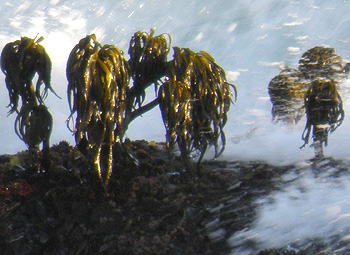 Sea palms thrive in what surfers call "the impact zone" - the area where the waves break hardest. (Source: Kim Fulton-Bennett) One highly visible alga that regrows from spores each year is the sea palm (Postelsia palmaeformis). When full grown, these inhabitants of the most exposed, wave-battered rocks look like rubbery, 14-inch-high palm trees. In February and March, however, tiny young sea palms are just beginning the tops of large boulders or exposed reefs. The slender young sea palms you see in March are the result of a long, complicated reproductive process that started the previous fall. Sea palms typically grow in close proximity to and compete for space with California mussels and goose-neck barnacles, both of which form dense colonies on lower intertidal rocks. In late fall and winter, sea palms release spores that settle like fine dust over the surrounding mussel beds. The vast majority of these spores are consumed by the mussels and barnacles, which are voracious filter feeders. However, a few lucky spores drift down between the mussel shells, where they spend the winter sheltered from the waves. In this protected environment, the spores attach themselves to the underlying rock and develop into microscopic bud-like growths called gametophytes. Over the next month or two, these tiny gametophytes somehow survive the winter storms that tear their parents right off the rocks. In the midst of all these storms, the tiny gametophytes develop sex organs and then release eggs or sperm (depending on the sex of the gametophyte) into the water. Once again, most of the eggs and sperm are eaten, but a few eggs manage to survive and to rendezvous with sperm. The fertilized eggs then settle back down between the mussels. If the mussel beds remain intact, these fertilized sea-palm eggs cannot sprout, and will eventually die. However, if a patch of mussels is ripped off the rocks by winter storm waves, the eggs have a fighting chance. Only when they are bathed in sunlight and exposed to nutrients in spring will they begin to germinate. Once the eggs germinate in February or March, the young sea palms grow very quickly, reaching full size within just a few months. Biologists call the full-sized sea palms "sporophytes" because they produce and releases spores, starting the process all over again. Among the various life stages of the sea palm, only the sporophyte stage is visible to the naked eye. Many annual kelps, including sea palms, bull kelp, and oar weed (described below) go through similar reproductive stages, and only sprout during a short period of time in early spring. Oar weed recolonizes lower intertidal rocks Oar weed (Alaria marginata) is another annual kelp that thrives in exposed areas such as the Big Sur coast. Alaria means "wing" in Latin, but to me the blades of this alga look like giant, slippery feathers. Each oar weed consists of a stubby 1- to 3-inch-long stipe supporting a seven- to ten-foot-long ruffled primary blade with a distinct central rib. At the base of the main blade are several shorter blades called sporophylls, which release spores as they disintegrate in fall. Oar weed grows on rocks from the lower intertidal to 12 feet below the sea surface. In this often turbulent environment, oar weed thrives, with up to 500 sporophytes growing on a square yard of rock surface. It is particularly good at colonizing large boulders (5-10 feet across) that are exposed to nearly constant wave action. Like sea palms, oar weed has a long and complicated reproductive cycle. The young oar-weed shoots visible in March started out as spores released during the previous fall or winter. Because oar-weed's sporophylls are short and grow close to the sea floor, oar-weed spores usually settle within a few yards of their parents. Thus, young oar-weed sprouts often colonize areas that were previously occupied by members of their own species. By February or March, most of the previous year's oar-weed sporophytes have been torn off by winter storms, providing space for the next generation. But a few decaying oar-weed holdfasts often remain. These apparently serve as nurseries for the next generation. In fact, as many as 30 to 60 young oar weed recruits can be found growing around the base of a single decaying holdfast. The only other place you are likely to find young oar weed recruits is underneath the branches of coralline red algae. These hardy perennials protect oar-weed spores, gametophytes, and eggs from grazers, winter storm waves, and exposure at extreme low tides. Each spring, hundreds of thousands of young oar-weed sprouts appear simultaneously in different parts of the Big Sur coast, popping up from underneath red algae or beside their parents' holdfasts. This sudden sprouting event usually takes place some time between February and April, but most often occurs in March. No one knows exactly what controls the timing of these mass sprouting events. Oar-weed eggs are not planktonic, so they are surfing fronts or internal waves to shore like some larvae. It may be that the eggs only germinate when sunlight increases to a certain level, when storm waves subside, or when the first major upwelling event brings cold, nutrient-rich water to the Big Sur Coast. Once sprouted, the young oar-weed sporophytes grow as much as two inches a day, and soon overshadow the red algae that sheltered them. The coralline red algae don't seem to mind too much--they just go dormant, living out the next six or seven months in the dim light of the understory. Within a month after the oar weeds sprout, they begin to create reproductive fruiting bodies called sorii. These form inside the sporophylls, creating large discolored splotches on the secondary blades. By the time oar weed finishes its growth spurt in July, the sorii will fully mature and begin releasing spores, setting the stage for the next generation. Coralline red algae serve as intertidal nursery areas 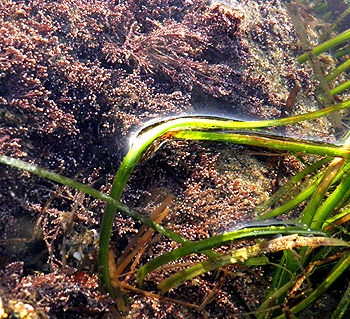 Coralline red algae serve as nursery areas for many small animals, as well as for surfgrass seeds. (Source: Kim Fulton-Bennett) Both encrusting and branching coralline red algae thrive along the edges of tide pools and on wave-swept intertidal rocks. These algae do most of their growing during winter, and often put on a last growth spurt at the beginning of upwelling. Thus, coralline red algae often appear bushy and lush in spring, even following stormy winters when almost all other algae have been damaged or destroyed. Later in spring, as sand fills in and larger algae colonize intertidal areas, the coralline algae grow more slowly and may even go dormant. The planktonic young of many intertidal plants, algae, and animals have evolved to "settle out" onto coralline red algae, which provides protection and, in the case of some animals, food. If you go out exploring Central Coast tide pools in March, it is always worth looking closely at clumps of coralline red algae. You never know what you'll find. Perennial red algae provide food and shelter Nailbrush algae Several perennial red alga are reliably present on intertidal rocks in early spring. One is the bushy and extremely durable nailbrush alga (Endocladia muricata), which becomes most abundant (or at least visible) in early spring. With high intertidal rocks relatively barren at this time of year, nailbrush algae provides precious shelter and food on these bare expanses of rock. Several different types of intertidal animals, including lined shore crabs, use this low algal "turf" as nursery areas. Turkish towel algae A second common perennial alga that survives the winter months is turkish towel algae (Mastocarpus papillatus). This alga takes many different forms, some of which were formerly classified as separate species. Some Mastocarpus form flat "tar spots" on otherwise barren rocks, which can survive winter storms and being buried in sand in summer. Others form short, brushy clumps a few inches high (like Endocladia). Still others grow leafy blades up to five or ten inches long, with rough, bumpy surfaces that give the alga its common name. Mazzaella algae Another red alga that looks similar to Mastocarpus and sometimes survives winter storms in abbreviated form are low turfy algae in the genera Mazzaella. These leafy algae are typically reduced to low stumps or tufts in the winter time, but begin growing back rapidly in spring. Gracilariopsis In wide, flat rocky intertidal areas in spring you may find long, thin strands of red alga in the genus Gracilariopsis swaying just above the seafloor. In some areas Gracilariopsis survives all year, but in rocky areas it sprouts in early winter, after the first winter storms sweep sand away from the shore, exposing bare rock. From their hiding places in hairline cracks in the rock, Gracilariopsis spores sprout and grow rapdily over the rock surface, reaching maximum lushness in spring. By summer, it often dies back or is smothered when beach sand moves back toward shore. In March you may still see some lush beds of Gracilariopsis, but other beds may already have been bleached by the sun or reduced to stubble by the movement of sand to and from the beach. Gracilariopsis often colonizes some of the same wide, flat rocky terraces as does surf grass, and can colonize areas somewhat higher up on the shore. It also serves some of the same ecological roles as surf grass, providing food and protection from waves for small animals, as well as trapping sand. However, Gracilariopsis beds are not typically as dense as surf-grass beds, and because they often die back in summer, do not provide the same year-round benefits to other intertidal organisms. Surf grass sprouts, regrows, and shelters other organisms 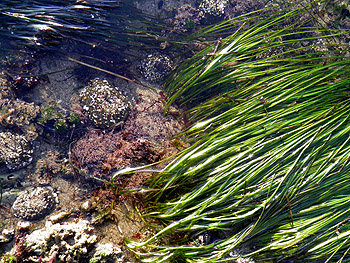 This surf grass is growing out of a small patch of sand in a tidepool. To the left of the surf grass are coralline red algae and anemones, both of which are very good at surviving being buried alive. The coralline red algae serve as a catch-point and nursery ground for surfgrass seeds. (Source: Kim Fulton-Bennett) Surf grass (Phyllospadix scouleri) is another perennial resident of intertidal areas, which provides a reliable, year-round habitat for many small animals. In spring, clumps of surf grass often put out new, bright green blades to replace older ones that have been damaged by winter surf. One way to tell the new spring blades of surf grass from the old ones is that the new blades are clean and smooth. Older blades may have broken or brown tips, and are likely to be infested with parasitic algae, limpets, and other small animals that graze on the surf grass or on its algal parasites. Surf grass is a flowering plant that originally evolved on land, but subsequently colonized the challenging rocky intertidal environment. Unlike the marine algae that dominate this realm, surf grass has true leaves, flowers, and seeds. Surf grass blooms in late fall and then releases seeds that hook onto segments of coralline red algae. The seeds look like tiny black horse-shoes with sharp, barbed ends. This shape has evolved so that it latches onto the branches of the algae, anchoring the young surf grass seedlings against winter storm waves. The surf-grass seeds typically sprout some time between January and March, then grow most rapidly once sunlight and nutrients become plentiful. After several years of growth, individual surf-grass plants often expand like crab grass to form dense mats that trap drifting sand (in fact, their root-like rhizomes look much like those of crab grass). Surf grass seems to grow best on flat rocky platforms that are overlain by a few inches of sand. Once established in such areas, such surf-grass beds are very long lived and may expand to cover hundreds of square feet of rock, right around the mean-low-tide level (the “0” tide level on tide tables). Although expanding clumps of surf grass may eventually smother the coralline algae that allowed them to germinate, the surf grass itself provides nursery areas and habitat for other types of red algae and small animals that grow beneath its thatch, protected from sun and wind. For example, the red alga Plocamium cannot tolerate bright sunlight, but is able to colonize intertidal areas by growing in the shade of surf-grass. The fact that Plocamium can also survive being partially buried in sand makes it even more at home in sandy surf-grass beds. Red abalone spawn 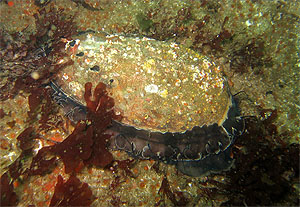 A red abalone (Haliotis rufescens) in a very unusual position - on top of a rock. Most of them wedge their shells underneath large rocks, where sea otters can't reach them. (Source: Ian Sayers/NOAA) If you are very observant and very lucky you may see the another animal that uses coralline algae as a nursery in March. This is the red abalone (Haliotis rufescens), one of the most well-known but seldom seen inhabitants of the intertidal and subtidal zone. Although red abalone are the most common species of abalone on the Central Coast, they are rare in shallow water due to persistent hunting by sea otters and humans. In Central California, red abalone typically spawn in spring, between February and April, with a peak in March. In Northern California, they spawn a month or two later--a pattern we will see repeated by many other organisms. Intertidal biologists seem to get a kick out of watching abalone spawn. One biologist described abalone mating as if it was a sporting event: "On a warm sunny day, just as the tide started rising, male abalone began to shoot out successive clouds of white sperm, while females released plumes of gray-green eggs." A report by the California department of Fish and Wildlife, on the other hand, described the process in more graphic terms: "At the commencement of spawning, abalone elevate their shells and begin twisting from side to side in a manner that actually squeezes out the gametes." Even from a purely quantitative standpoint, abalone spawning is pretty amazing. A single female red abalone, during a single spawning event, can release up to 12 million eggs. Drifting around in a tide pool or kelp forest, these eggs will only be fertilized if they happen to come in contact with sperm that are released simultaneously by male abalone during the same spawning event. Needless to say, most of the abalone eggs are not fertilized. But they do provide a temporary bounty for predators such as young rockfish and for filter feeders such as barnacles. The abalone eggs that survive and are fertilized sink rapidly to the sea floor, where they hatch in a matter of hours. Out of the eggs come microscopic abalone larvae that look like tiny "throw pillows" with fringes of hair-like cilia. All those beating cilia propel the tiny larvae up off the sea floor and into the water column. For the next five to fourteen days, the little larvae drift and swim with the waves and currents, feeding all the while on small, early-spring diatoms. Laboratory studies suggest that red abalone are most likely to spawn when the sea water is a relatively warm 55-68 degrees Fahrenheit. In fact, one of things that can trigger red abalone to spawn (in the laboratory) is a sudden warming of the water. This might seem surprising considering that red abalone typically spawn at the beginning of the upwelling season, when water temperatures often drop rapidly. Perhaps the key is having that "warm sunny day," when nearshore waters can be heated by the sun. Alternatively, the abalone might spawn when relaxation fronts carry relatively warm water toward the shore immediately following an upwelling event. Abalone larvae might benefit in several ways if they are released during a relaxation event. For one thing, the larvae might find plenty to eat since, blooming phytoplankton are often carried toward shore by relaxation fronts. In addition, the shoreward-flowing currents during relaxation events might help keep the young abalone larvae close to shore. This effect would be enhanced by the fact that abalone larvae are often released just after low tide, when tidal currents begin flowing toward the coast. Young abalone develop most rapidly when they are provided with plenty of food and relatively warm water. Thus, abalone larvae may grow faster if they are released during a relaxation event. This would reduce the amount of time the abalone larvae spend drifting in the plankton, which in turn would make it less likely that the larvae would be carried offshore or eaten by other drifting animals. Whatever their strategy, larval abalone are remarkably successful at staying near shore--genetic studies have shown that they often settle down and colonize the same kelp bed or intertidal area where they originally hatched. After a week or two drifting with the currents, the abalone larvae develop hard shells, which soon become so heavy that the larvae start to sink. As they approach the sea floor, the tiny abalone must somehow find and choose just the right environment in which to settle down. They seem to avoid light and seek out dark crevices and the undersides of rocks. They also like to settle among the blades of red coralline algae, which, as mentioned before, are relatively abundant and conspicuous in March. After settling, the young abalone graze on encrusting red algae or on thin films of bacteria and diatoms that grow on the sides of rocks. These bacteria and diatoms are the first organisms to colonize rock surfaces that are cleared by or broken by winter storms. Thus, another reason possible reason that abalone may spawn preferentially in early spring is that cleared rock areas are common at this time of year. After they settle down under rocks and start munching on red algae, young abalone grow relatively slowly--by the end of their first year, their flattened oval shells may be only an inch or two across. During their second spring, these "yearling" abalone begin to emerge from their crevices and boulders to forage in the open. They also switch from grazing on red algae and diatom films to feeding on drift kelp, which will remain their staple food for the rest of their lives. Just as some animals, such as a rockfish, are "ambush predators," you might call adult abalone "ambush herbivores." An adult abalone spends most of its time sitting quietly on an exposed rock with the edges of its shell slightly lifted. When a strand of kelp drifts near the edge of the shell, the abalone quickly clamps its shell down, holding the kelp in place. The abalone then leisurely consumes the kelp, gradually pulling the algae beneath its shell and into its mouth, like a little boy slurping up a piece of spaghetti. Hungry abalone sometimes adopt a slightly more active feeding strategy, which is described in a California Department of Fish and Wildlife report as follows: "Abalones are able to detect food only at close proximity. Once food is detected, the abalone carefully glides slowly along, feeling its way, until it reaches the alga. It then raises its foot and comes down on the plant, trapping it beneath its body. It then consumes the alga, using its small rasp-like teeth and extruding tongue, which often measures one-third of the animal's total body length." Red abalone seem to prefer giant kelp and bull kelp over other types of drift kelp available in central-coast tide pools. However, in a pinch (so to speak), they will eat many other types of kelp, including oar-weed, feather boa kelp, and Pterygophora. When times are really hard, red abalone will eat red algae or even green algae such as sea lettuce (Ulva), but they don't get as much nutrition from these algae as they do from giant kelp. How fast an abalone grows depends on how much algae and what types of algae are available for it to eat. For example, red abalone grow relatively slowly and are less likely to spawn during years when the kelp beds are thin and giant kelp is scarce. Similarly, the number of young red abalone that appear in tide pools varies greatly from year to year, with an occasional year of high "recruitment" alternating with several years during which few, if any larval abalone colonize intertidal rocks. Purple sea urchins spawn Like red abalone, purple sea urchins (Stronglyocentrotus purpuratus) eat mostly drift kelp, and typically spawn in early spring, between January and March, though they may also spawn at other times of year. Their fertilzed eggs develop and hatch within a day or so, releasing microscopic larvae that drift in the currents for 2 to 3 months before settling back onto intertidal rocks around the peak of the upwelling season. Note: A related species of red sea urchins (Strongylocentrotus franciscanus), which live in deeper water, also appear to spawn in spring, and have a similar larval period. These urchins are described in the page about kelp beds in April. Lined shore crabs settle onto coralline red algae Young abalone are not the only animals that use perennial red algae as a nursery in spring. Another animal (and a much more visible one) is the lined shore crab (Pachygrapsus crassipes), whose young settle out of the plankton throughout the spring upwelling season. If you look carefully at red algae in the upper intertidal, particularly coralline red algae or the bushy red nailbrush algae (Endocladia muricata), you may find tiny shore crabs that have recently settled out of the plankton. Upper intertidal rocks, particularly in early spring, are relatively barren because of scouring by winter waves. Nailbrush algae provide one of the few protective hiding places on these bare expanses of rock. Several different types of young animals use this low algal "turf" as hiding places and nursery areas. The tiny shore crabs hiding in tufts of nail-brush algae have spent the last six to nine months drifting around in the plankton, after hatching from eggs the previous summer or fall. If red abalone are one of the rarest tide pool animals on the Central Coast, lined shore crabs must be one of the most common and visible. With their bright green and red striped shells, lined shore crabs can often been seen crouching in cracks or crawling over high intertidal rocks. These crabs, whose bodies range from less than an inch to over three inches across, are extremely tolerant of exposure to air, as well as to huge changes in water temperature and salinity. You can often see shore crabs scraping thin films of algae or diatoms off the rocks using spoon-like cups on the edges of their claws. Perhaps, like young abalone, the newly settled crabs benefit from the fact that bare rocks with diatom films are common in early spring. Adult lined shore crabs also eat larger algae, including the green alga Ulva, brown algae such as Fucus, and red algae such as Endocladia. Not just vegetarians, lined shore crabs have been seen using their claws to pry limpets off of rocks and to catch and eat other live animals, including kelp flies. Barnacles begin to colonize intertidal rocks In the spring competition for space on intertidal rocks, barnacles are one of the most persistent competitors, spawning early and often. Several different types of barnacles release larvae starting in January or February. By March, these larvae have begun to drift toward shore and recolonize intertidal rocks. Although barnacle larvae often colonize intertidal rocks in a series of pulses throughout the spring and summer, those barnacles that settle out in early spring are most likely to find bare rock surfaces available for colonization. Barnacles feed by waving their frilly legs through the water to filter out phytoplankton, zooplankton, and bits of debris that come drifting by. Barnacles that settle in early spring may also benefit from the small phytoplankton and other food particles that are abundant at this time of year. For example, several species of barnacles settle onto rocks in late February, when smaller Skeletonema diatoms are most likely to bloom. By the time the larger Chaetoceros diatoms bloom in March or April, these young barnacles will have grown big enough to feed on the larger diatoms. In the following paragraphs, we'll look at a few of the barnacles that are you are most likely to find colonizing intertidal areas during March. Acorn barnacles settle out Probably the easiest barnacles to find are the tiny gray or brown acorn barnacles in the genus Chthamalus, which colonize the highest intertidal rocks. Larvae of acorn barnacles begin to settle out between January and March, with a peak in February. Additional pulses of acorn-barnacle larvae may appear sporadically through summer and fall; female acorn barnacles release up to sixteen broods of larvae a year with up to 3,000 larvae in each brood. Acorn-barnacle larvae spend two to four weeks drifting as plankton before being carried back to shore (if they are not carried offshore or eaten first). Pulses of barnacle larvae often settle during periods of southerly winds that accompany late-spring storms or the relaxation of upwelling. One study in northern California found that every relaxation event between June and August resulted in a distinct pulse of barnacle larvae settling on intertidal rocks. Acorn barnacles often form broad colonies that look as if someone had simply flung them up onto the rocks far above the intertidal zone. In fact, this is what actually happens in early spring, when high tides and steep, wind-driven waves splash acorn-barnacle larvae up onto high (and often dry) rocks. The newly settled (and still microscopic) larvae hunker down in tiny cracks and depressions to avoid drying out or being eaten by grazing limpets. Over the next few weeks, the larvae develop very rapidly and may start spawning when they are only two months old and just 1/8 inch across. Acorn barnacles live higher up in the intertidal than any other type of barnacle, often spending more than half of their time completely out of the water. Some species can survive even if they are never actually submerged, but only wetted by sea spray and wave splash. In fact, their feeding legs can often be seen extending up into the open air after a brief wave splash has wetted the rock around them. One slightly sadistic marine biologist kept a colony of acorn barnacles in a dry aquarium for three years, immersing them in sea water only once every three months. Amazingly, most of the barnacles survived. In another experiment by the same researcher, acorn barnacles survived four months in fresh water--a treatment that would that would kill almost any other marine animal in a matter of hours. Despite living under such seemingly harsh conditions, acorn barnacles often form dense colonies, with as many as 70,000 animals sharing a single square meter of rock. Some researchers have suggested that acorn barnacles are so small and live so high up on the rocks that they are not worth the trouble for many predators such as sea stars and whelks, which readily consume larger barnacles that live lower down on the rocks. However, the young of some predatory snails and small sea stars may be just the right size to feed on acorn barnacles. Tetraclita barnacles settle Another type of barnacle that colonizes bare rocks early in spring (from February through April) is Tetraclita rubescens. Like acorn barnacles, Tetraclita spawn throughout the spring and summer, and their larvae spend about a month in the plankton. Like their smaller relatives, Tetraclita larvae that settle out in early spring have the best chance of finding bare rock surfaces and plenty of phytoplankton food. As adults, Tetraclita rubescens are large, reddish barnacles with cone-shaped shells that often acquire an eroded, "thatched" look in older animals. They are usually solitary, and live in mid-tidal areas where there is plenty of wave action (but also lots of predators). If not eaten by a hungry dog whelk or sea star, Tetraclita rubescens can live for 10 to 15 years, growing to between one and two inches across--large enough to resist being eaten by some predators. Unlike the prodigal and prolific acorn barnacles, Tetraclita barnacles do not begin to reproduce until they are about 2 years old. Goose-neck barnacles settle A third type of barnacle that settles on intertidal rocks between February and April is the goose-neck barnacle, Pollicipes polymerus. The large, dense colonies of goose-neck barnacles are easy to see as they hang off the sides of rocks and compete for space with mussels in the mid- to upper-tidal zone. Goose-neck barnacles typically breed with their neighbors starting in early spring. Goose-neck barnacles are hermaphroditic--each animal releases both eggs and sperm, so they can both fertilize and be fertilized by their neighbors. After a goose-neck barnacle's eggs are fertilized, it carries the eggs within its body for about a month. Then, some time between February and April, it releases three to seven broods of larvae, with several hundred thousand larvae in each brood. When you consider the thousands of goose-neck barnacles living in a single large colony (not to mention all those acorn barnacles on the higher rocks), it's easy to see why there might be a lot of barnacle larvae floating around the nearshore waters during spring. After drifting around in the plankton for about three to four weeks, the goose-neck barnacle larvae are ready to return to shore and settle to the bottom. Along the exposed coast, goose-neck barnacles only settle on the shore during relaxation events. In especially sheltered areas, such as within the Monterey Bay upwelling shadow, goose-neck barnacles may settle throughout the upwelling season because the larvae are apparently retained near shore. Predatory snails hatch and eat young barnacles Coinciding with the arrival of lots of tiny young barnacles is the hatching of young snails in the genus Nucella, which prey on young barnacles. Adult snails mate and lay eggs during the winter months. These eggs hatch in early spring, just in time for the young to hunt newly settled acorn barnacles.
Tunicates regrow
Like the perennial brown algae described earlier in this chapter, some intertidal animals have found ways to survive the winter by shedding nonessential body parts. For example, many colonial tunicates (also known as "sea squirts") die back in winter, leaving just a thin gelatinous base attached to the rock.
Although little more than a coating of slime, this "basal body" saves the tunicate's space on the rock, by preventing algae and animals from settling, as they would on a bare rock surface.
When winter storms subside in March, little buds begin to form on the basal body. Within a month or two, these bumps have grown into adult tunicates and have begun feeding on spring-bloom diatoms. Most of these tunicates reach maximum size and spawn in June or July.
One type of tunicate, however, gets much earlier start on things. The orange cave tunicate (Ritterella pulchra) releases its larvae in March and April, often during the morning hours, when the ocean is relatively calm. As soon as the young larvae come upon an unoccupied vertical rock surface, they attach themselves to it. Within three or four days they have developed into adults and have begun feeding on plankton.
By summer each individual cave tunicate will have cloned itself several times to create a colony of bright orange, one- to two-inch-long tunicates. Perhaps the orange cave tunicate spawns earlier in the year than other tunicates so that its young can take advantage of the algae in the spring bloom.
Overwintering shorebirds leave while pigeon guillemots arrive
March is a time of transition for Central-Coast birds, including the birds of the tide pools and nearshore waters. In rocky coastal areas you may see groups of robin-sized black or gray birds picking at the seaweeds. These are probably either black turnstones or surf birds. Both birds spend their winters on the Central Coast, but leave the area in March or April to breed north of here.
Swimming and diving right in the surf zone, you may see small flocks of surf scoters--small duck-like birds that hunt small clams and shrimp-like animals stirred up by the waves. A little farther from shore, you may see small flocks of western grebes or a few Pacific loons. Like the turnstones and surf birds, all of these seabirds feed along the Central Coast during winter, but in March are getting ready to head out for summer nesting areas in the Arctic. We'll look at their migration in greater detail in April.
At the same time as the scoters and other nearshore birds are leaving the Central Coast, another small coastal bird is just arriving. This is the pigeon guillemot, which arrives on the Central Coast in March after foraging far out in the open Pacific ocean during the winter months. By April, the guillemots will begin nesting in burrows on rocky cliff faces.
Black oystercatchers perform mating rituals
The only tidepool bird that remains on the Central Coast all year round and nests locally is the black oystercatcher (Haematopus bachmani). These large black birds blend in surprisingly well with the dark intertidal rocks... especially considering that they have pink legs, flame-red bills, and bright yellow-orange eyes. Even if you don't see them, it's easy to hear their high, shrill cries cutting through the roar of the breaking waves.
If you go exploring Central-Coast tide pools in March, you may be lucky enough to see a pair of black oystercatchers doing their courtship dance on the a rocky low-tide terrace. First the male oystercatcher bows and hops around the rocks, screeching and trying to establish his territory and attract mates. Once he attracts the attention of a female, he flies toward her and she takes off.
With loud cries, the two birds play an aerial game of tag, screeching as they arc back and forth over the tide pools. Eventually they land on a rocky ledge and bow repeatedly to each other until the male suddenly hops up on the female's back and they mate.
You can often see pairs of oystercatchers hanging out or feeding together even when they are not courting or mating. In fact a single mating pair may return to nest in the same tide-pool area year after year. The only time you are likely to see large groups of oystercatchers is during winter (particularly following winter storms), when they congregate on a few isolated beaches northwest of Santa Cruz.
Field observation: A gathering of oystercatchers One gray afternoon in early March I watched one group of oystercatchers that had gathered at Davenport Landing beach, just north of Monterey Bay. A late winter storm was approaching. High clouds had gathered overhead and dark, lowering clouds were headed in from offshore. I was strolling out on a long, flat rocky ledge with the tide on the rise.
When I first approached the rock ledge, I didn't see any birds at all--just bare, gray rock punctuated by a few clumps of mussels and two- to three-inch-tall tufts of Turkish-towel algae. Scanning the rocks with my binoculars, I spotted two or three shorebirds, then half a dozen. I eventually realized that perhaps 50 birds were feeding on that one ledge, including dozens of surfbirds and eight or ten oystercatchers.
The oystercatchers were feeding in the tide pools, wedging their bills into crevices and underneath rock ledges and then working them back and forth like little crowbars. Sometimes an oystercatcher would stick its entire head into a crevice, the better to see and reach its prey. When an oystercatcher caught some hapless little tide-pool animal, it would yank the creature out of its hole, hold it up carefully in its bill, then, with a quick upward tilt of the head, swallow it whole.
As the tide rose, the oystercatchers began moving back across rock ledge, using their beaks like little shears to pick tiny crustaceans out of the tufts of red algae. The foraging oystercatchers worked first on one tuft and then another, with all the fastidiousness and precision of English gardeners working on their shrubberies.
As the tide rose even farther, some of the oystercatchers began napping, their bodies facing into the wind, their heads turned back, and their bright red bills tucked under their wings. As soon they hid their neon bills, the oystercatchers became virtually invisible.
Suddenly a larger wave washed up over the rock platform. The napping oystercatchers all looked up, walked inland a few yards, and started feeding again. Perhaps the incoming surge of water inspired tide-pool animals to come out of their hiding places, and thus gave the oystercatchers new opportunities for hunting.
No one knows exactly why the oystercatchers gather in large groups during winter. Perhaps it has something to do with the preparation for the mating season, though I saw no obvious signs on courting or mating on that gray afternoon in Davenport.
|

